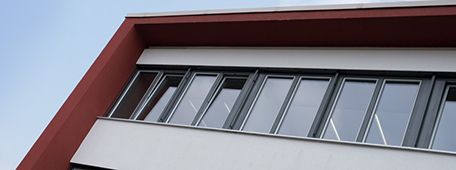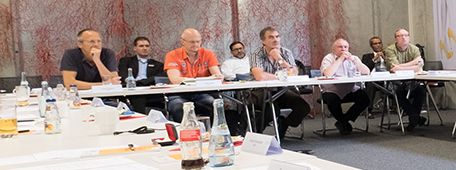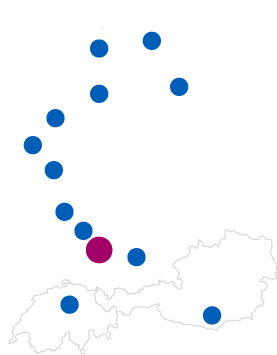City of Trossingen
Integrated energy management
The topic of energy management is a top priority for the Baden-Württemberg city of Trossingen. The city has already recorded energy consumption for the roughly 45 buildings it manages over the past few years. Project managers felt this wasn’t enough, as one of their key goals was to identify potential energy savings and develop possible measures for energy improvement.
Challenge
To implement this requirement in practice, the second largest city in the Tuttlingen district – which has 15,000 inhabitants and is ideally situated in the Black Forest Baar-Heuberg region – decided to introduce software-supported energy management. The Infoma newsystem module facility management offered them the solution they needed. The process was introduced in 2012 as part of a conversion to double-entry Infoma newsystem financial accounting. It was selected because of its high integration capabilities within the system, and because it eliminated interface connections as well as duplicate data and functions, and would allow the city to avoid maintaining multiple different software products. It laid the groundwork for reducing and optimizing costs and energy consumption by delivering an objective analysis of potential energy savings that could be implemented inexpensively. Only a good basis of information, made up of updated and transparent data, can give project managers a comprehensive overview of the complex technical interactions at play.
The administrative buildings in Trossingen – including schools, nurseries, museums, the fire department, halls, apartment buildings, and homeless shelters – are supplied with power by subsidiary company Energieversorgung Trossingen GmbH. The company delivers gas, district heating, and – since 2011 – certified green electricity produced with 100 percent hydroelectric power. “We wanted to illustrate existing energy consumption in an energy report, providing decision-makers clear figures in just a single step,” Sandra Kurz from the Trossingen town administration says, explaining their decision. She describes some of the expectations the city included in its requirements catalog: “Our goal was to install a uniform information and controlling system with clear presentation and evaluation of consumption, costs, and emissions. At the same time, we wanted to show areas of weakness so that we could identify organizational improvements or investments to improve the situation if necessary.”
Solution
The Axians Infoma team handled preparation of the energy report, because the city of Trossingen didn’t have the capacities to do so. “That’s why Axians Infoma completed the energy report according to our specifications,” Sandra Kurz says. “We based it closely on the requirements of the KEA (Climate protection and energy agency) of Baden-Württemberg template and the guideline “Energy management and municipal properties” from the Baden-Württemberg Economic Ministry.”
An energy report was completed for 21 buildings in 2013, including the general structure with table overview, floor area information, 5-year consumption figures, costs and emissions, and individual analyses for each building. Automated reporting was completed using various functions in the Energy management module. That means that Trossing now has a general list of buildings analyzed, with addresses and floor areas, as well as energy statistics. This provides a detailed overview of consumption, costs, and CO2 emissions for all buildings over the last five years, including changes from the previous year, subdivided by the energy types electricity, heat, and water. At the same time, the reports provide key figures on consumption and floor space that can be used to compare the buildings’ consumption with other buildings. In addition, the energy report for each building includes an analysis listing suggestions for changes, the year of construction, changes already made, etc. Further tables list consumption, costs, and emissions for each individual building.
All managed buildings will be included in the energy report by the end of 2014. As a next step, Sandra Kurz plans to book energy provider invoices using the Energy management module: “This hasn’t been the case in the past, since we’ve only recorded some of our buildings. Currently invoices are still being processed through integrated financial accounting. That means that we still generally aren’t able to save time here. But we’ve taken that into consideration. Our top concern was clear: to move energy management forward.”
In the medium term, Trossingen plans to use the integration of Financial accounting and Facility management more efficiently. In addition, they are considering handling maintenance management through the Infoma newsystem process. The Maintenance, repair, and inspection module has the functions they need to do so.
Benefits
Even if they haven’t yet recorded all buildings, Sandra Kurz’s initial conclusion after one year of use is positive: “It’s definitely an advantage for us that we have the consumption data combined in a clear and easy to understand report, adjusted for weather conditions, that we can use for comparisons, instead of just on internal Excel lists. That makes the figures easier to understand, and they can be used for discussions or similar purposes at any time.”
The Energy management module offers Trossingen a detailed overview of consumption, costs, and CO2 emissions for all buildings over the last five years.
Key data
Product Energy management
State Baden-Wuerttemberg
Number of inhabitants
15.392
Double-entry financial accounting from Infoma newsystem since 2010, and Financial accounting with the Energy management module in use since 2012.


























